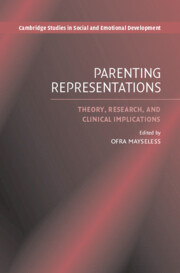Book contents
- Frontmatter
- Contents
- List of Illustrations
- List of Tables
- List of Appendixes
- List of Contributors
- Preface
- Acknowledgments
- Part One Theoretical Perspectives
- Part Two Research Applications
- 4 Communicating Feelings: Links Between Mothers' Representations of Their Infants, Parenting, and Infant Emotional Development
- 5 The Dual Viewpoints of Mother and Child on Their Relationship: A Longitudinal Study of Interaction and Representation
- 6 Modeling and Reworking Childhood Experiences: Involved Fathers' Representations of Being Parented and of Parenting a Preschool Child
- 7 Maternal Representations of Parenting in Adolescence and Psychosocial Functioning of Mothers and Adolescents
- 8 Like Fathers, Like Sons? Fathers' Attitudes to Childrearing in Light of Their Perceived Relationships with Own Parents, and Their Attachment Concerns
- Part Three Clinical Implications
- Index
- Cambridge Studies in Social and Emotional Development
- References
5 - The Dual Viewpoints of Mother and Child on Their Relationship: A Longitudinal Study of Interaction and Representation
from Part Two - Research Applications
Published online by Cambridge University Press: 10 July 2009
- Frontmatter
- Contents
- List of Illustrations
- List of Tables
- List of Appendixes
- List of Contributors
- Preface
- Acknowledgments
- Part One Theoretical Perspectives
- Part Two Research Applications
- 4 Communicating Feelings: Links Between Mothers' Representations of Their Infants, Parenting, and Infant Emotional Development
- 5 The Dual Viewpoints of Mother and Child on Their Relationship: A Longitudinal Study of Interaction and Representation
- 6 Modeling and Reworking Childhood Experiences: Involved Fathers' Representations of Being Parented and of Parenting a Preschool Child
- 7 Maternal Representations of Parenting in Adolescence and Psychosocial Functioning of Mothers and Adolescents
- 8 Like Fathers, Like Sons? Fathers' Attitudes to Childrearing in Light of Their Perceived Relationships with Own Parents, and Their Attachment Concerns
- Part Three Clinical Implications
- Index
- Cambridge Studies in Social and Emotional Development
- References
Summary
Abstract
This chapter addresses behavioral and representational facets of the mother–child emotional tie at two developmental periods: towards the end of infancy and towards school entry. Using data from a longitudinal study with low-risk mothers and infants (Scher, 1991), we examined the predictive validity of mothers' sensitivity when playing with their 12-month-olds to parenting representations at age six years. The Attachment Story Completion Task (Bretherton, Ridgeway, & Cassidy, 1990) was administered to 42 children; their mothers (n = 26) participated in the Parent Development Interview (Aber et al., 1985). It was found that high maternal sensitivity during infancy was a precursor of mother's representations of her parenting competency, provision of secure base, and low levels of negative emotionality. Higher levels of negative emotionality, described by the mothers, correlated concurrently with more negative representations of the maternal figure in the narratives of the children. Mothers' sensitivity to the child's feelings correlated with more frequent representations of the mother as a protective figure in the children's stories. The links over time and across domains and perspectives are considered within the frameworks of attachment theory and psychoanalytic approaches.
The study of parenting is a fast-growing field that has yielded a comprehensive body of knowledge, with diverse perspectives (see Bornstein, 2002). Yet many questions remain unanswered on the interplay between the behavioral and representational levels in parent–child relationships.
- Type
- Chapter
- Information
- Parenting RepresentationsTheory, Research, and Clinical Implications, pp. 149 - 176Publisher: Cambridge University PressPrint publication year: 2006
References
- 1
- Cited by



